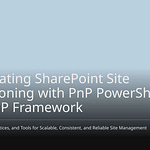Most companies think rolling out Microsoft 365 is job done. But here’s the kicker: adoption isn’t transformation. If your Teams channels look busy but collaboration still feels like email with emojis, you’re not alone. The hidden gap is cultural, not technical. And that gap is where your rollout begins to stall quietly. In this session, we’ll show you why M365 success only comes when technology, mindset, and organizational relationships move forward together—because if one lags, the tools don’t matter. So, is your M365 rollout quietly failing?
The Hidden Trap of 'We Already Rolled Out M365'
Most leaders assume that because Microsoft 365 is rolled out, the real work is done. The licenses are active, Teams is live, and SharePoint sites are online. From an IT dashboard, the numbers look strong—logins are up, storage usage keeps climbing, and graphs show adoption rising every single month. On paper, it looks like success. But is it? That’s the trap many organizations fall into. Equating deployment with transformation feels natural, because the measurable side of a rollout is easy to track. The messy, human side is harder to capture and often gets ignored.
Think about it: when Teams first launched in your company, usage exploded. Channels popped up overnight, conversations flowed, and files landed in shared spaces instead of inboxes. From a surface view, it looked like people had embraced a new collaborative environment. But if you asked those same people how it felt, many quietly admitted it was overwhelming. Conversations scattered, decision-making stayed the same, and the “collaboration culture” everyone hoped for never quite clicked. What you had was activity, but not necessarily progress.
There’s a story from a manufacturing company that illustrates this perfectly. Their IT department proudly reported strong adoption numbers: Teams active daily, SharePoint libraries filled with documents, and employees accessing company portals regularly. Leadership praised the IT staff for a successful transformation. Yet, HR surveys painted a very different picture. Users felt they were wasting more time than before, struggling to locate current information, and drowning in overlapping sites. The rollout checked every technical box, but employees were frustrated, and productivity gains never appeared. This disconnect isn’t rare—it’s almost the norm.
The easiest way to explain it is through an analogy: rolling out Microsoft 365 without cultural change is like buying a home gym. You can unpack all the equipment, pay for the subscription, and even set up a routine in an app. But until you consistently integrate that workout into your life, nothing changes in your health. The presence of the tool doesn’t guarantee results. M365 is the same. Owning Teams or Viva doesn’t make a company collaborative. Usage data only tells you that someone clicked the login button. It doesn’t show if they found value or if they quietly went back to old habits.
This is why looking at technical adoption stats can be misleading. A company may proudly announce “ninety percent of employees use Teams daily,” but ask those employees what they actually do, and you’ll hear a different story. Some only join scheduled calls. Others keep a chat thread with their department but never engage beyond that. Actual engagement—measured through depth of collaboration, innovation in workflows, and improved decision-making—tells a very different story than raw usage numbers. The fact that someone logged in doesn’t mean their working habits actually changed.
And here’s the tension: behavior doesn’t shift just because a new button appears on the ribbon. A culture that relied on email doesn’t magically transform into a dynamic, transparent collaboration model overnight. Pressuring staff with mandatory Teams channels or scripted intranet check-ins often backfires, making the change feel like an additional burden rather than a better way to work. This is where so many rollouts falter—they underestimate how powerful habits and workplace norms can be.
To bridge this gap, you need something more than rollout checklists. This is where the idea of a “meta perspective” comes in. Instead of looking at M365 as tasks to complete or tools to activate, it means zooming out and viewing the technology as part of a longer journey. Adoption is not about the switch from email to Teams, or from fileshares to SharePoint. It’s about aligning these changes with how people relate, how leaders communicate, and how the business itself grows. Without that longer horizon and shared perspective, the rollout tops out at compliance, not transformation.
That realization is the mini-payoff here: just because a tool is deployed doesn’t mean it transformed your business. Rollout only signals the starting line, not the finish. Once leaders see this clearly, the conversation shifts away from usage reports toward building a culture that continuously evolves with the toolset. When that happens, Microsoft 365 is no longer just a suite of apps employees are told to use—it becomes an environment that reflects and reinforces how the company works together.
And that’s the point at which we stop asking if the rollout succeeded and start asking how M365 can grow as part of the organization itself. Which leads to the deeper question: what happens when we stop treating these apps as isolated tools, and begin viewing them as a living system with culture baked right in?
Why a 'Meta Perspective' Changes Everything
What if the real game changer isn’t the tools at all, but how far you zoom out to view them? Most organizations work with Microsoft 365 as if it were a set of software packages to deploy. Install Teams, launch a SharePoint intranet, activate Viva—tick the boxes, send out the change emails, and consider the job complete. That’s one way to look at it. The problem is that this perspective assumes value is created at the moment deployment ends. Yet the actual story of collaboration, communication, and adoption stretches far beyond the finish line of a project plan. The tools are just the beginning; the real question is how they evolve inside the company over years, not months.
If we approach M365 only through operational rollouts, the horizon stays short. The logic behind project plans is to declare victory once the tools are “live.” But culture doesn’t run on technical deadlines. Employees don’t suddenly alter how they cooperate just because a new site or channel exists. Habits take time, leadership support has to be sustained, and systems require ongoing refinement. When companies stop at launch, they effectively freeze innovation at the point of deployment. What starts as momentum quickly flattens into routine.
And this is where tension builds. In most companies, IT aims to be efficient: stable logins, clean audits, and smooth integrations. Leadership has a different lens—often centered on growth, innovation, and shaping the organization’s future. Meanwhile, users are thinking about something else entirely. They simply want to get their work done without extra friction added to their day. Those three perspectives—IT stability, executive vision, and user tasks—rarely align from the start. Imagine three arrows all pointing in different directions. Even if each arrow individually looks correct, the overall force doesn’t move the business forward. It creates drag, not velocity.
In practical terms, that’s why intranets stall, Teams channels sprawl, and employees drift back into old habits. Each group thinks it is contributing to transformation, but because the vectors don’t overlap, everyone ends up pulling against one another. IT sees adoption, leadership sees stalled innovation, and staff feel more burdened than supported. The lack of coherence is rarely recognized because every team points to its own metrics of success. The friction only becomes clear once people admit that collaboration hasn’t improved and decisions still feel bogged down.
Consider the experience of ST Extruded Products Germany. Their M365 journey didn’t reveal its real shape in the first year, or even in the second. It was only after five years of ongoing work that patterns came into focus. They realized that progress wasn’t about perfecting Teams, or squeezing SharePoint into a glossy intranet template. It was about seeing the entire system as one living environment where IT, business goals, and daily user needs had to fit together. The “whole” perspective made individual frustrations start to make sense. Small inefficiencies weren’t isolated failures—they were signals of a deeper need to treat the platform as a continuous development process.
And this is the critical shift. Once you recognize Microsoft 365 as a long horizon journey, every decision changes. Instead of chasing quick deployments, you think about the phases of user confidence, leadership commitment, and cultural reinforcement over years. A team may not adopt Viva insights the first year, but if the strategy considers how employee experience evolves, the tool has room to take root later. Rollouts stop being endpoints and instead become milestones in a longer arc of change. The ongoing nature of collaboration means the “finish line” never appears, which is frustrating if you want closure, but powerful if you want lasting transformation.
So what happens when you treat M365 development as continuous instead of finite? You begin to align IT reliability with leadership vision and employee needs in ways that reinforce one another. Those three arrows don’t point in separate directions anymore—they start moving together. IT keeps the lights on, business leaders see technology contributing to growth, and employees feel supported with tools that reduce friction rather than create it. That alignment doesn’t just protect the investment in Microsoft 365, it maximizes it over time.
This is what we mean by a meta perspective. It’s not just zooming out to a larger picture, but holding that picture steady over a long period, so short-term clashes get absorbed into a bigger trajectory. The purpose isn’t to manage tools one by one, but to shape an ecosystem where people, goals, and collaboration patterns gradually synchronize. That synchronization doesn’t reveal itself overnight, but once underway, it reshapes how the company thinks about technology in general.
And that brings us to the next layer of the story: when platforms like SharePoint or Viva stop being just technical containers for information, and instead become touchpoints of culture that influence how people connect, learn, and build trust inside the company.
SharePoint, Viva, and the Aha Moments
Ever built an intranet that looked polished, had all the corporate branding in place, maybe even a slick homepage banner—only to discover a month later that hardly anyone was using it? That’s the exact frustration many organizations run into with SharePoint and Viva. The tech team builds carefully, leadership signs off proudly, but when employees open it up, the excitement fades fast. At ST Extruded Products, that scenario played out almost step by step. The structure made perfect sense in design workshops, but once it landed in the hands of staff, cracks became obvious within weeks.
The biggest stumbling block wasn’t the platform itself, but the mismatch between what IT thought employees needed and what workers actually cared about. Navigation was heavy, hierarchy was complex, and the whole thing felt like yet another layer people had to wrangle instead of a place that made their work easier. Ownership was also fuzzy. Who updates this section? Who archives that document? Instead of empowering employees, the intranet unintentionally made decisions harder. Several people described the experience like opening a file cabinet that was already too full. Everything technically existed, but finding the one piece of information you needed took energy most workers didn’t have to spare.
The team assumed that employees wanted dedicated pages for every department and detailed announcements published in a formal layout. What came through quickly in user feedback was the opposite. People didn’t want endless static pages—they wanted conversations. They wanted places where questions could be asked and answered openly, where updates were not just read only, but part of a flow. That was the first big “aha moment.” Instead of investing more into a glossy homepage, the real need was simplifying conversations so they felt like part of actual work.
This disconnect is common. Organizations love the idea of a central intranet but underestimate just how much design choices affect engagement. If one extra click stands between an employee and information they need daily, adoption drops instantly. Research on intranet usage consistently shows that complexity kills momentum. Employees stick when a site feels natural to their workflow, when there’s clear ownership of content, and when updates mirror the rhythms of how teams already share knowledge. In other words, the more digital spaces feel like human behavior, the more likely they are to thrive.
At ST Extruded Products, course-correction only happened once they started testing directly with staff instead of assuming what they needed. As employees began voicing frustration, leadership and IT shifted strategy and pivoted to aligning the intranet with actual work habits. One team realized that weekly updates buried deep in a corporate news page weren’t being read. When those same updates were surfaced in simpler feeds and tied to Viva dashboards, readership spiked instantly. That was another “aha moment”—value didn’t come from perfect formatting, it came from cutting friction.
This is also where the role of Viva turned out to be eye opening. Originally seen as an add-on, it emerged as a way to bridge the emotional and cultural gap. Viva Insights, for example, wasn’t about another report; it was about reminding employees when to pause, reflect, or connect. Suddenly, the intranet wasn’t just about publishing, it was about how people felt at work. That changed the conversation. SharePoint moved from being a static storage site to becoming a backbone where communication felt alive, while Viva added the connective tissue that supported culture and balance.
Framing these platforms as cultural infrastructure instead of publishing tools flipped expectations. Rather than measuring success through numbers of pages or documents uploaded, success started to look like whether people trusted the space as reliable, whether they went there first when they needed clarity, and whether they felt comfortable sharing openly. The intranet transformed from a digital shelf gathering dust to a genuine living space where collaboration practices were shaped daily. To achieve this transformation required iteration. Every round of feedback highlighted something different—some tweaks worked, some didn’t—but the act of listening and adjusting turned the system into something far more resilient than a project launched once and then forgotten.
The bottom line here is straightforward: technical build alone solves nothing. You can deploy the best-designed SharePoint site, activate premium Viva modules, and still fail if people don’t see them as meaningful. The lesson is that success hinges on engagement, continuous feedback, and iterative adjustments. The journey at ST Extruded Products proved that an intranet only works when employees recognize it as a space to connect, not just as another repository managed from afar. Tools become powerful when they are woven into the way people want to work, not when they extend the top-down structures that already frustrate them.
And if refining an intranet environment reshapes culture this much, it’s worth asking: what happens when even more transformative tools—like Teams—entrench themselves into workflows and begin changing not just where information lives, but how it flows in real time every single day?
Teams Rollout: The Effects That Won’t Go Away
Once Teams shows up, it doesn’t go away. You can uninstall other apps, you can retire intranet pages, but Teams has this way of baking itself into the daily rhythm of the entire organization. Meetings, chats, files, tasks—it becomes the constant layer that everything else sits on. At ST Extruded Products, the rollout of Teams reshaped communication so thoroughly that even after years, it still defines how people expect to interact at work. The platform stopped being “another tool” and turned into a baseline expectation for how information moves.
The early days looked promising but messy. Employees were quick to jump into chat threads, create new channels, and move their conversations out of Outlook. That part almost felt liberating. But the sudden flood brought its own problems. Duplicate content crept in everywhere—sales had their channel, but then so did operations, with overlapping posts that confused everyone. Documents landed in multiple team folders without anyone sure which version was “the one.” Some teams created private groups instead of using the official spaces, and suddenly critical updates were fragmented. The boundaries of where information should live blurred fast.
People joked it was like email with emojis—and in some ways, that’s exactly how it worked at first. Teams chat replaced the constant back-and-forth of email, but the volume didn’t drop. Now it was scattered into threads, replies, and channel posts, sometimes hidden deep in a conversation that nobody saw until hours later. IT logs suggested soaring activity, but from the user’s side, it was still chaos—just presented in a different package. This was a reality check: simply moving conversation into a new platform doesn’t automatically make it clearer or easier.
Over time, though, Teams started to leave marks that couldn’t be ignored. People began expecting instant responses. Where email once allowed for a day’s delay, a chat ping in Teams carried the unspoken rule of “reply now.” That subtle shift changed work rhythms. Colleagues knew who was available in real time, and managers began assuming more constant access. It led to friction in some cases, but it also led to a breakthrough: conversations became more transparent. If you wanted to understand a decision or see a discussion, you didn’t wait for someone to summarize—you opened the channel and saw it played out.
New informal networks also emerged inside Teams. Conversations that once happened only in office hallways or after meetings now had digital equivalents. A quick private chat between two engineers might spiral into a wider thread, sparking collaboration across departments. That kind of cross-connection simply didn’t exist with email. It turned out to be a hidden benefit that encouraged knowledge to move horizontally through the company rather than always climbing vertically through managers first.
Managers, however, had their own challenges. For some, Teams gave more visibility into how projects moved forward. For others, it created the pressure of constant oversight. Threads revealed gaps in accountability, and suddenly people could see who responded quickly and who disappeared when tasks came up. Trust and authority started to look different. IT also felt the strain. Provisioning teams, managing lifecycle policies, answering endless questions like “where should this document live?”—the operational load was heavier than a simple rollout would have predicted.
The long-lasting effects are still visible years later. What began as a chat and meeting tool hardened into the backbone of a digital-first work culture. Teams didn’t just streamline conversations, it rewired how authority functioned inside the organization. Leaders who once controlled the agenda by managing meetings now found discussions happening in channels where they were participants, not gatekeepers. Visibility meant people at all levels could see progress or delays without waiting for formal reports. Trust wasn’t only about titles anymore; it became about responsiveness, clarity, and how transparent you were in the shared workspace.
That’s one of the surprising takeaways—it wasn’t just about replacing email or reducing meetings. Teams altered the social contract of the workplace. Once conversations lived in open channels, relationships adjusted. Employees had greater confidence speaking up, decision-making sped up when the right voices joined threads, and transparency itself became a form of authority. Culture shifted not because of a policy, but because the platform nudged people into new behaviors and didn’t let them easily slip back.
The big lesson here is simple but weighty: Teams isn’t just a piece of software. Once embedded, it reshapes habits, expectations, and even what leadership looks like. The tool rewires culture not by instruction, but by how it structures daily interaction. That’s why its effects don’t fade with time—they only deepen as people internalize its rhythms.
And if one collaboration tool can change culture this profoundly, it raises the next question. As organizations start experimenting with artificial intelligence layered on top of M365, what kind of cultural rewiring should we expect there?
The Human Factor: Attitude, Relationships, and the AI Future
The secret? It’s not in the code, it’s in the culture. When companies wonder why their shiny new platform isn’t producing better teamwork, the answer usually has nothing to do with missing features. It almost always comes down to mindsets, habits, and relationships. You can roll out the slickest internal portal in the world, but if employees don’t trust that what they find is reliable, they will still lean on old networks and side conversations. Culture shapes behavior, and without addressing it, technology alone can only scratch the surface.
Many organizations confuse tool proficiency with transformation. They invest heavily in training sessions about how to navigate SharePoint, how to create Teams channels, or how to use Viva dashboards. Employees complete the modules, know where to click, and technically know how the system works. But knowing how to click through a menu isn’t the same as believing the system is worth engaging with. That second part—the emotional adoption—is often overlooked. If staff don’t see a reason to move their critical work inside the platform, they’ll stick with email, calls, or even personal workarounds. Technology explains the “how,” but culture answers the “why.”
Think about it like driving a car. IT can give meticulous training on how to operate the engine, the brakes, and the dashboard controls. They can even test to make sure employees are certified drivers in the new environment. But none of that decides where people will drive. A workplace full of trained drivers might still have everyone sitting in the parking lot if trust and clarity about the destination are missing. Without leadership actively guiding how the tool contributes to purpose, employees default to the roads they already know best—even if they’re less efficient.
The experience of ST Extruded Products is worth pausing on here. Their rollout worked not because of perfect technical steps but because leadership attitude set the tone. When managers showed consistent support, explained why changes mattered, and modeled usage themselves, employees picked up the behaviors more readily. There was less resistance, not because policies demanded it, but because trust in the leadership message gave credibility to the shift. Contrast that with companies where managers quietly bypass the new tools or only demand compliance from their teams without engaging themselves. In those environments, no amount of training sticks. Attitude from the top can accelerate adoption or stall it flat.
And this is where the parallel to AI adoption becomes clear. We are on the edge of similar narratives with artificial intelligence tools being woven into the Microsoft 365 ecosystem. AI promises efficiency gains, smarter insights, and reduced manual tasks—but only if people actually trust and use it. If leadership treats AI as a mandatory productivity engine without addressing employee concerns, the same gap we saw in M365 adoption reappears. The tools will exist, the usage numbers may look acceptable, but the real behavioral changes will lag behind. Cultural acceptance is the difference between a chatbot gathering dust and a digital assistant employees rely on daily.
That’s the warning sign worth listening to. If trust, mindset, and culture aren’t aligned, the rollout of AI will repeat the same cycle we’ve already seen—excitement from IT, pressure from management, and lukewarm follow-through from users. And just like with Teams or SharePoint, the data may hide the problem because clicks don’t equal transformation. Companies risk mistaking technical presence for actual change.
Technology evolves fast. Features appear, updates roll out, and new modules drop every few months. What doesn’t keep up at the same pace is human behavior. Teams need time to settle into routines, people need proof that their input matters, and relationships need to adjust so collaboration feels natural rather than forced. Sustainable transformation happens when technology, people, and culture advance together. Leave one out, and the other two can’t carry the load for long.
That triad is the real measure of digital maturity. A company that buys every license but ignores culture is no more advanced than a company running on email alone. What makes the difference is how well tools fit with attitudes and how trusted relationships leverage them. Once that balance is in place, technology investments stick, behaviors change, and momentum builds with each iteration. That’s not a checklist IT can complete on its own—it requires leadership, trust, and user ownership working alongside the technical foundation.
Which is why the journey with Microsoft 365 is more than tools or specific app rollouts. It’s a roadmap for how organizations will handle the even bigger waves ahead. The challenge isn’t figuring out the latest feature set—it’s building a culture resilient enough to keep transforming, whether with M365 today or with AI tomorrow.
Conclusion
Tools by themselves never change how a company works. What actually shifts collaboration is the mix of attitude, trust, and the relationships people build around the tools. That’s why one rollout thrives and another stalls, even with the same software stack. So here’s the challenge—don’t just ask if M365 is deployed. Ask if it’s evolving as part of the culture. Are leaders modeling the change? Are employees shaping how it grows? Because in the end, if culture and relationships lag behind, the presence of the tool doesn’t matter. The investment sits there, underused, while habits stay the same.











